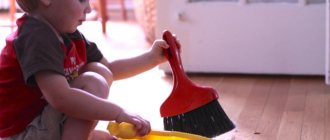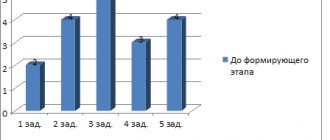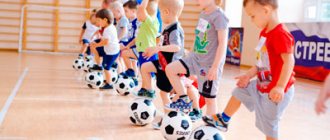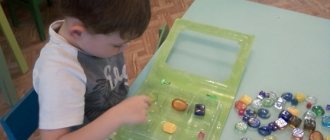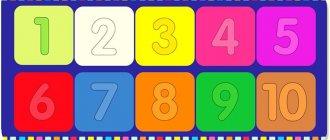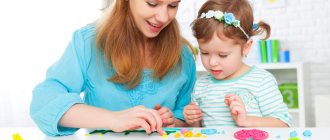Maria Montessori believed that a child's intelligence and knowledge of the world always originate in the senses. Any thought is always preceded by a process of collecting information. This means that the more subtly all the analyzers work, the more chances a person has to solve the problem facing him.
In his book “The Absorbent Mind of the Child,” M. Montessori says that sensory development allows you to open up a whole new world for the baby, making more things and their properties visible, as if someone suddenly turned on the light in a dark room.
It is important to understand that what adults consider obvious, a child has yet to learn: a small stone is lighter than a large stone, but at the same time heavier than a feather, glass is smooth and cold to the touch, and an autumn leaf is warm and rough. A child's absorbent mind is wired for learning, but it is important to place the child in the right environment where he can put his natural curiosity to use.
For more information about Maria Montessori's approach, watch our webinar for parents:
History of Sensory Education in Montessori
Maria Montessori was not the first teacher to draw attention to the importance of developing children's senses. When developing her approach, she relied heavily on the work of the French physician and teacher Edouard Seguin, who at one time worked with children with special needs and created his own system of exercises for developing children’s perceptions and teaching them everyday skills. Jean-Jacques Rousseau and Johann Heinrich Pestalozzi in their works also paid attention to the role of the development of sensory organs in children's learning.
Robert Baden-Powell, founder of the Scout movement and contemporary of Maria Montessori, said that to gain knowledge about the world, children need real experience of interacting with objects. This statement formed the basis of his theory of active learning. He highly valued Maria Montessori's pedagogical approach, noting that if teachers stop commanding and begin to more delicately reinforce a young child's natural need for new experiences, teachers can create a much more solid basis for subsequent learning and development. In his opinion, the idea of education as hard and exhausting work is hopelessly outdated.
Maria Montessori herself began her career working with special needs children who were deprived of adequate sensory stimulation: they had almost no toys, and their whole life was reduced to a series of basic caregiving activities. She was able to clearly prove that changing the living conditions of children significantly changes the level of their abilities. Today, the influence of the environment on a child’s development has been proven at the neurophysiological level. We recommend reading John Medin's book, Rules for Your Child's Brain Development, to become more familiar with this topic.
Maria Montessori created a system of sensory education based on many years of experience observing children and studying the works of outstanding teachers and doctors. Although she was not the first to discover the need for sensory experiences in child development, she was certainly the first educator who was able to draw public attention to this fact.
Development of sensory abilities of preschoolersconsultation on the topic
Development of sensory abilities of preschool children
Sensory development of a child is the development of perception and the formation of ideas about the external properties of objects: their shape, color, size, position in space, as well as smell, taste, etc. Knowledge begins with the perception of objects and phenomena of the surrounding world - sensory abilities form the foundation of mental development . With the development of sensory perception, the baby’s ability to master aesthetic values increases. Already at preschool age, children are faced with a variety of shapes, colors and other properties of objects, in particular toys and household items. They also get acquainted with works of art - painting, music, sculpture. Every child, one way or another, perceives all this, but when assimilation occurs spontaneously, it often turns out to be superficial and incomplete. The process of developing sensory abilities is worth guiding.
Sensory education is included in the activities of preschoolers, taking into account the age of the children and their level of development, type of activity, basic patterns and features of the development of sensory abilities in children.
Sensory perception is a very complex and active process that requires significant analytical and synthetic work. In the process of sensory perception, motor components are always included (feeling objects and eye movements, highlighting the most information points; singing or pronouncing the corresponding sounds, which play a significant role in determining the most significant features of the sound stream).
Early age is most favorable for improving the functioning of the senses and accumulating ideas about surrounding activities. Sensory education, on the one hand, forms the foundation of the general mental development of the child, on the other hand, it has independent significance, since it is a condition for the successful mastery of any practical activity.
The richness and variety of sensory impressions received from surrounding activities makes the child’s life richer and brighter. The poverty of impressions causes the appearance of a negative emotional state. To develop a child’s analyzers means to teach him the actions of examining an object, which in psychology are called perceptual actions. With the help of perceptual actions, the child perceives new qualities and properties in an object. During this period, the child learns to display individual properties of objects that are essential for his movements (certain features of the shape, size of objects, distance). It is the adult who can promptly teach the child these actions.
Every person, as soon as he is born, is already ready to perceive the world around him: he is able to see, hear, feel heat and cold. Early preschool age is considered the most favorable for the development of sensory abilities, sensory perception, sensory standards, and sensory culture. This is the most favorable time for sensory education, without which the formation of a child’s mental abilities is impossible. This period is important for improving the activity of the senses, accumulating ideas about the world around us, and recognizing the baby’s sensory abilities.
The main task of adults is to structure their work with the baby in such a way as to maximally develop the child’s sensory abilities. From an early age, develop sensory standards, sensory perception, and form the child’s sensory culture.
Formation of standards
In the development of sensory abilities, an important place is occupied by the assimilation of sensory standards - generally accepted examples of the external properties of objects. The seven colors of the spectrum and their shades act as sensory standards of color, geometric figures act as standards of form, and the metric system of measures serves as standards of size. The child’s acquaintance with sensory standards occurs in the following sequence. First, he is introduced to the main samples, and then to their varieties. In this case, different standards must be compared with each other and called first an adult, and then a child. Only then will they be well fixed in memory. Drawing, modeling, appliqué, origami, and embroidery successfully develop sensory abilities. The assimilation of acquired knowledge is facilitated by games when the child independently draws, and then paints and cuts out various figures.
Blue, light blue, green...
Sensory standards in the field of color perception are the so-called chromatic colors of the spectrum (red, orange, yellow, green, blue, indigo, violet) and achromatic colors (white, gray, black). By the age of five, a child, as a rule, knows the primary colors - except blue and purple. At five or six years old, you can move on to forming an idea about them. Blue is especially difficult to “learn”: children often confuse it with blue. Therefore, before introducing the color blue, you need to give the child an idea of shades, the location of color tones in the spectrum. Familiarization with shades makes it possible to compare light blue and cyan colors, establishing their difference, and mastering the spectral sequence allows you to define the blue color as “located between green and blue.” It is also important to teach children of this age to distinguish four to five shades by lightness. Their attention should be drawn to the fact that some light shades have special names in everyday life (for example, light red is called pink).
Circle, square, oval...
Mastering form standards presupposes the ability to recognize the corresponding form, name it and be able to find a use for it, and not analyze it in terms of the number and size of angles, sides, and other things. By the age of five, a child should know five basic shapes: square, triangle, circle, rectangle and oval. Next, you need to introduce new shapes, introduce the child to the varieties of ovals, triangles, rectangles, etc. The main thing is that the child can distinguish between them.
Wide, narrow, very narrow...
Mastering standards of size is somewhat more difficult than mastering standards of shape and color. The quantity does not have an “absolute” meaning, and its determination is made through conditional measures. Mastering them is a rather complex task that requires certain mathematical preparation; it is very difficult for preschoolers to solve it. However, the use of the metric system is not necessary for perception. An item may be judged to be "large" in comparison to another item, which in this case is "small". Thus, ideas about the relationships in magnitude between objects act as standards of magnitude. These representations can be denoted by simple words indicating the place of an object among others (“big”, “small”, “smallest”). At the age of five to seven, children need to be taught to compare first two or three, and then a larger number of objects that form a series of decreasing or increasing values - in this case, simultaneous training in comparison techniques is required. In addition, mastering the standard of size at this age presupposes the child’s ability to distinguish the length, width and height of objects.
Training in examination methods
When sensory standards are mastered, it is necessary to teach the child to use them as samples when examining various objects. The most difficult task for preschoolers is to evaluate the combination of colors, shapes and sizes of objects with a complex structure.
Red or cherry?
The child will quickly learn to perceive the color of specific objects - this is not difficult when the objects have a relatively pure color. However, when the color contains elements of different tones, expressed to varying degrees (for example, coffee, chocolate, burgundy and others), the task becomes difficult, requiring special training and the ability to isolate and distinguish objects with different color shades. It is not enough to be able to accurately perceive individual colors and shades. In nature and works of art, colors are found in complex combinations. A child of five to seven years old needs to be taught to see these combinations, to catch a certain rhythm in the arrangement of individual tones, to distinguish colors called warm from the range of cold ones (warm - from red to yellow, cold - from green to purple).
Round or oval?
Teaching a child to examine the shape of an object is, first of all, teaching the ability to see the similarity between the shape of an object and a simple geometric figure. Then it is important to teach the child to verbally indicate the shape of this object (a TV is rectangular, a plate is round, etc.). However, few objects have a simple shape that clearly resembles some kind of geometric figure. In most cases, the shape is more complex: one can distinguish the general outline, the shape of the main part, the shape and location of the secondary parts and individual additional details. At five to seven years old, a child should learn to examine complex forms. Perception of the shape of a complex structure presupposes the ability to visually split it into individual elements corresponding to certain geometric patterns, and determine the relationship of the elements. For example, when a child draws a house on a piece of paper, he first draws a large rectangle, then a roof in the shape of a triangle or trapezoid, then small rectangular windows, etc. At all stages of learning how to determine the shape, you can use a simple technique - ask the child to trace outline of an object and its parts. This helps him compare the traced shape with the standards.
Small or short?
Training in examining the size of objects should be aimed mainly at developing the eye. To do this, you can teach your child to solve increasingly complex “eye” problems. First, he learns to compare two objects, placing one next to the other, and to select by eye two objects that are equal in total size to the third. Then he must master a more complex method of examining a quantity - learn to use the simplest measure. For example, when choosing an object that is equal to a sample, a child measures the sample with a strip of paper, and then uses this measurement to find an object of the required size. When moving on to tasks using the eye, you should keep in mind that they are quite difficult even for a seven-year-old child. However, as special studies show, the level of visual actions can be increased during targeted training. The eye develops in constructive activities - when the child selects the necessary parts that are missing for construction, in modeling - when he divides a lump of clay so that there is enough for all parts of the object, as well as in drawing, appliqué and, of course, in games.
“Pick a bow to match the dress” Didactic task: develop the ability to group shades of color. Develop fine motor skills. Material: Dolls cut out of cardboard, dressed in dresses of different colors, colorful bows. Instructions: the child is asked to help the doll choose bows to decorate the dresses. The bow should be the same color as the dress.
The teacher shows one doll at a time and asks the children one by one (what color is her dress), clarifying their answers. Draws attention to the fact that the same color has different shades). Today is our dolls' holiday, and they asked us to help them choose bows to decorate their dresses. The bow should be the same color as the dress.
Exercise “Connect the picture” Didactic task: Development of thinking, development of visual perception, the ability to find differences and common properties of objects. Material: Silhouettes of teapots, toys, cars, etc. made of cardboard, cut into pieces. Instructions: children are invited to help Dunno collect pictures from parts. Children select the necessary parts from the box on the table and assemble the picture.
“Repair the rug”, “Repair the clothes” Didactic task: teach to distinguish colors and use the names of colors in speech. Strengthen the ability to recognize geometric shapes and name them (circle, triangle, square). Develop fine motor skills of the hands, color perception, attention. Materials: printed form of the technique, scissors, glue. Silhouettes of clothes cut out of cardboard, geometric shapes Instructions: the form shows a round “mat” with bear cubs drawn on it. In one place “the rug is torn” - a fragment of the picture is missing. Assignment: choose a suitable “patch” for the “rug” from the 5 proposed fragments. To check the correctness of his decision, the child can cut out the “patch” he has chosen and stick it on the “mat.”
In order to obtain the maximum effect, classes on the development of sensory skills are organized under the condition of a positive emotional attitude in the child. A child’s sensory development is best developed through didactic games. Didactic play occurs in inextricable connection with the development of logical thinking and the ability to express one’s thoughts in words. To solve a game problem, you need to compare the characteristics of objects, establish similarities and differences, generalize, and draw conclusions. Thus, the ability to make judgments, inferences, and the ability to apply one’s knowledge in different conditions develops. This becomes possible only if children have specific knowledge about the objects and phenomena that make up the content of the game. Thus, sensory development forms the foundation of the child’s overall mental development and has independent significance, since full perception is necessary for the child’s successful education in kindergarten and school.
Rules for organizing sensory education according to Montessori
Maria Montessori noticed that at a certain age, children's behavior and motivation are very similar. For example, in the first three years a child is especially sensitive to order. This childish “pedantry” is necessary for the child to create a stable image of this world. It can also be used to develop a child’s natural need for knowledge by creating tasks that are exciting for a certain age, which would help the child master the most important qualities of objects: color, size, shape, material.
As Maria Montessori herself admitted, the work of creating the sets was not easy: it was necessary to create material that would demonstrate properties in isolation, have pedagogical value, and at the same time be attractive to the child. This is how a set of Montessori sensory material appeared.
The main objectives of Montessori sensory exercises
- Teach the baby to perceive, compare and classify sensory experiences of different modalities,
- Expand the child’s sensory experience, teach him to notice even small differences, develop the child’s senses as much as possible,
- Teach your child to use his own memory: “I remember what yellow is, and I can always imagine it in my head,”
- Teach to critically evaluate any information and develop the habit of striving for maximum accuracy when gaining knowledge about the world,
- Create a basis for the emergence of abstract thinking and imagination.
Let us explain with an example how sensory and abstract thinking are connected:
Let's say you've never seen an okapi. Now your task is to imagine this animal by description: it is a bay horse with the legs of a zebra and the head of a giraffe. Happened? If so, congratulations, your sensory development is on point, because for this exercise you need to have an understanding of the colors of horses, the coloring of a zebra and the body structure of a giraffe.
Any abstract idea is essentially a clever interweaving of various information from our real experience. That is why a child’s intelligence begins in early childhood and the ability to exercise all the senses over and over again.
What can you find in the sensory development area of the Montessori center?
Visual information
- Shapes: sets of geometric shapes, as well as more complex shapes (for example, animal figures or plant leaves)
- Volumetric figures: Pink Tower, Brown staircase, Red barbells, Montessori weight cylinders
- Colors: sets of basic colors, card index of shades
Tactile information
- Texture: palpable board, rough tablets, baskets with rags
- Temperature: heat jugs, heat plates
- Weight: weighing cylinders and plates
Stereognostics
- Sorting small items, magic bag
Audio information
- Volume: sound boxes, musical accompaniment of classes
- Height: bells, sound cylinders, musical instruments
Taste and smell
- Taste bottles, conversations during meals
- Jars with scents
In addition to exercises with isolated sensory qualities, in a Montessori space you can always find sets that combine several qualities, such as color and shape:
- Binomial cube
- Trinomial cube
- Constructive triangles
- Montessori squares
- Cylinders without handle
The study of sciences according to M. Montessori also begins with sensory education. Acquaintance with the basic qualities of objects of the natural and cultural world prepares the child for studying social sciences, biology, physics, chemistry and even mathematics:
- Sets of leaves of different plants
- Thematic puzzles
- Maps and globe
- Flags
- Sets with natural materials
- Reproductions of artists and nature photographs
What is sensory development in children
For the full upbringing of children, sensory development plays one of the most important roles. It is based on the formation of perceptions and ideas about the form and properties of objects. Sensory development plays an important role in early preschool age. It helps to create a general picture of the world around him in the baby’s head.
Beginning of sensory perception
What is this in pedagogy, definition
In pedagogy, sensory education is the development of sensations, ideas and perceptions. This is not only about introducing the baby to all the functions, but also about their targeted improvement.
Why is it so important for children
Sensory development of young children is activities that are based on the assimilation of the properties of an object. This is what underlies the development of mental abilities. Further learning depends on how correctly sensory education is structured at an early stage.
On a note! Children master and study the shapes of objects, materials, and phenomena naturally while playing, looking at pictures, or listening to music. If at this moment no help is provided from adults, then the perception will be the same as the baby’s. Most often, this leads to the fact that perception remains incomplete.
That is why it is very important that adults have control and help. It should consist of explaining the diversity of the surrounding world, replenishing the vocabulary to describe the properties of phenomena and objects.
Sensory education according to the Federal State Educational Standard should be organized in a multi-stage manner. The task of the learning process is to form certain standards in children. It is important to do everything correctly, as this is necessary for further teaching activities and children’s competent perception of new information.
It is important that the baby can not only distinguish and identify objects by their properties, but also be able to apply this knowledge to other objects. For example, the mathematical standard of shapes is the ability to identify the simplest shapes.
Mastering the properties of objects
What is the basis of sensory education?
The basis of sensory education is the joint activity of children with teachers. Game and practical situations allow you to accumulate and generalize knowledge. Practical activities include the following:
- working with a variety of materials;
- drawing with paints, crayons, pencils;
- modeling;
- reading stories and fairy tales;
- study of painting;
- design;
- motor activity.
For preschoolers, work activity plays an important role. During labor, the child develops a system of knowledge about tools, forms of labor, and methods of execution.
Construction as a means of sensory education
Sensory development tasks
The goal of sensory education for children is to enrich their sensory perception. On this basis, the following tasks are set:
- formation of various actions for examination;
- creation of sensory standards, the ability to generalize ideas about properties;
- teach children to denote objects in one word.
On a note! For each activity there must be integrity of perception and representation.
Montessori Sensory Development Ideas at Home
Despite the fact that Montessori centers use specialized kits for the development of children, it is not difficult to create a game that enriches a child’s sensory experience.
- Animal competitions. Discuss with your child how different animals move and try to organize a competition: draw a start and finish line and ask them to run sideways like a crab, hobble like a bear, or jump like a hare.
- Modeling. Kinetic sand, salt dough, plasticine and clay perfectly develop a child's tactile sensitivity. You don’t have to try to create a masterpiece right away: just learn how to roll balls, flatten them into pancakes, stretch them into sausages, squeeze them and watch how the material seeps through your fingers
- Draw with crayons on the pavement and play hopscotch. Like the previous exercise, this trains not only the senses, but also the child’s coordination.
- Game of silence. Is it just not interesting to remain silent anymore? Invite your child to remember 5 different sounds that he heard during a minute of silence (car horn, bird sounds, people talking, a dropped pencil, etc.)
- Treasure hunt. Draw a list of objects that your child should find during your next walk (a long rough pine cone, a red leaf, a yellow leaf, a dry branch, etc.). Don't forget to take a pen with you to cross out what you find.
- Drawing with stamps, fingers, brushes and even cotton swabs. It is difficult to overestimate the impact of free creative activities on a child’s development.
- Guess the smell. Place items with different scents in opaque boxes: your favorite shampoo, orange peel, a little vanilla, dried cloves, fried cutlet. Organize a competition for the keenest sense of smell.
- Experiment with musical instruments: xylophone, glucophone, kalimba, drum, tambourine, shaker, pipe. It is not necessary to immediately enroll in a music school to introduce your child to music.
- Guess the product by taste. Blindfold your child and ask him to guess what's for lunch today.
- Let your child walk barefoot more often, because there is a whole world under his feet: sand, lawn, stream, pebbles.
Sensory development of preschool children (4-5 years old)
In middle age, preschoolers begin to experience role-playing interactions in play. During play activities, children begin to realize that everything happens for the sake of the meaning of the game. This allows for the active development of visual activity. A special role is given to drawing. It becomes objective.
For example, a child at this age must realize that a person has eyes, a mouth, a nose, hair, fingers, and elements of clothing. There is an improvement in visual activities.
On a note! Children begin to draw shapes on their own, understanding their purpose, and master the skills of cutting with scissors and gluing parts. The concept of design is introduced.
The basics of sensory education for middle-aged children also include the following:
- Developing the skills to create buildings according to your own ideas.
- Development of both gross and fine motor skills.
- Particular attention is paid to the coordination of movements and dexterity of the child. He must have good balance, step over obstacles, and be able to play with the ball.
- Perception becomes more developed. Children should be able not only to recognize geometric shapes, but also to understand what objects are similar to them.
- The concepts of size, color, length and width are well developed.
- Orientation in space has been improved.
- Preschool children's memory capacity increases. They can remember eight names of objects. Voluntary memorization is formed. The child is already able to understand the task assigned to him, they remember the instructions given to them by their parents or educators.
- There is an active development of imaginative thinking. You can use schematic images to solve the problem assigned to you.
- Children can come up with a short fairy tale or story on their own. Awareness of the interaction of events develops.
- Attention becomes more stable. A child of four years old can already concentrate on one task for more than 15 minutes. When performing an action, he can remember the condition that must be met.
- Diction and pronunciation of sounds improves. Speech in children becomes more developed. At this age, speech disturbances that were previously observed may be corrected. The development of the grammatical aspect is progressing well.
- The child’s communication with adults changes significantly. It becomes more educational in nature. The child is increasingly interested in information that is difficult for him.
- From the age of 4 to 5 years, the need for respect from adults plays a major role in development. It is very important that parents and educators give praise.
Lesson on fine arts on the topic “Mimosa” in the 1st and 2nd junior groups of a preschool educational institution
Sensory development at this age is also reflected in relationships between peers. Selectivity appears, children are divided into separate groups. Leadership begins to emerge. Competitiveness is important for the development of a child’s own image.
Important! It is necessary to direct the development of middle-aged children in the right direction. Help them form the correct idea of their image, take a position among their peers in the group!
Development in drawing
Sensory development of children aged 5 years and older
At the age of five, the most critical age begins before preparing for school. Children already clearly know the concepts of shapes, colors, and are able to compare one object with another according to their properties. They have already accumulated significant experience in tactile sensations.
The task of educators and parents is to consolidate existing knowledge. At the age of 5 to 6 years, preschoolers are already able to play intellectual games. This should be actively used in educational activities. For example, you can arrange quizzes after each topic covered.
Chess, checkers and children's lotto are great for this age. This not only trains attentiveness, but also memory and logic. It is best to focus on group games and role-playing activities from the age of five.
On a note! Activities on learning the rules of the road can be used as educational games for preschoolers. Here you can come up with both quizzes and role-playing scenes. This method will help not only to effectively consolidate new material, but also to train sensory skills.
After the age of five, special attention should be paid to the communication abilities of children. This is an important aspect of education for future schoolchildren. To do this, you often need to use group work and collective creativity. The task of educators is to help a preschooler find his place among his peers.
Games for preschoolers
conclusions
The development of a child begins with the development of his senses. In the 21st century, this is not just the opinion of teachers, but a scientifically proven fact. At an early age, it is very important for a child to learn as much as possible about the world around him using all his senses, which is why no computer can replace a child’s real experience of being in a different environment (forest, park, store, kitchen, etc.). Try to introduce your baby to a variety of objects, and think about how to organize a sensory development area for him, if the ideas of Maria Montessori are close to you.
